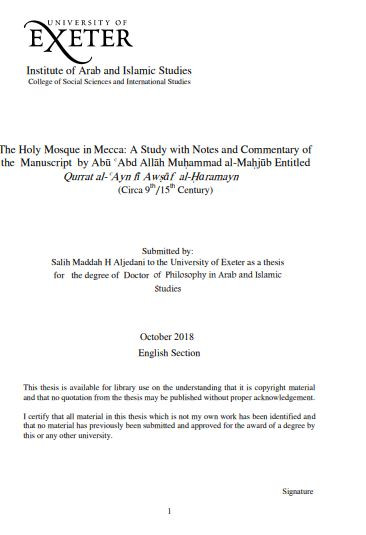
This thesis sheds light on one of the most important topics in Islamic history in the architectural developments of the Holy Mosque. Additionally, the work completes the gap in this field in the period of the 9th/15th century, through an examination of the manuscript by Ab] <Abd All[h Mu+ammad al-Ma+j]b entitled Qurrat al-<Ayn fī Awṣāf al-|aramayn (Delight of the Eye in the Description of Holy Mosques). As far as the researcher knows, the manuscript has not been investigated, until now. The first and largest part of the manuscript relates to the Holy Mosque in Mecca; the thesis examines the academic implications of the manuscript; analyzing, criticizing and comparing the author’s observations with four Muslim and Western travellers. The research is composed of two sections; the first will be in the English language comprising of six chapters. The first chapter contains an introduction to discuss the significance of the research; posing and addressing research questions, stating aims and objectives, highlighting the research methodology, an outline of the study and Literature Review. The second chapter contains a biography of the author, including his academic status, a bibliography, the Environment in which al-Ma+j]b wrote his manuscript as well as his death. It also contains information about the handwritten copies of the manuscript, content, significance and sources of the manuscript, as well as the methodology of the author. The third chapter will be discussing the key historic and architectural developments of the Ka<ba and the Holy Mosque, in prehistory until the 9th/15th century. The background to this thesis briefly discussed the architectural developments that occurred in al-Ma+j]b’s era. The fourth chapter will be followed by a discursive analysis of the Ka<ba, where the researcher compares the architectural developments of the Ka<ba with al-Ma+j]b’s views to show the similarities and differences between four travellers’ views and al-Ma+j]b’s accounts. Chapter Five will be followed by a descriptive investigation; discussing and comparing the architectural development of the Holy Mosque; cross-referencing the information to show the accord and contrast between travellers’ and al-Ma+j]b’s views. Lastly the thesis will evaluate the manuscript in providing academia with vital information about the Holy Mosque in the 9th/15th century. Chapter six will be followed by a scholarly review, evaluating the Holy Shrines as described by al-Ma+j]b and a study of the Holy Shrines giving both Muslim and Western travellers’ viewpoints; next the thesis contains a comparison of the architectural developmental aspects of the Holy Shrines from the perspective of al-Ma+j]b. Ultimately the thesis is concerned with the legacy of the al-Ma+j]b manuscript relative to and its contribution to illuminating lesser-known aspects of the Holy Shrines in the 9th/15th century. The thesis contains a summary, conclusion, giving the most important results reached by this thesis. The second section of the study is in Arabic; this is concerned with the production of the text of the manuscript of the first and biggest section of the manuscript dealing with the Holy Mosque, and the Holy Shrines of Mecca.
Aljedani, S., ‘The Holy Mosque in Mecca: A Study with Notes and Commentary of the Manuscript by Abu Abd Allah Muhammad al-Mahjub Entitled Qurrat al-c Ayn fi Awsaf al-Haramayn (Circa 9th/15th Century)’ (Unpublished doctoral thesis: University of Exeter, 2018).
I agree to the terms outlined below:
You agree to upload and assign Mosqpedia Database the rights to use the content worldwide and in perpetuity across all current and future media platforms. Mosqpedia Database may edit, copy, adapt and translate your contribution.
The content will be distributed under the Creative Commons Attribution-Deed – Attribution-NonCommercial-NoDerivatives 4.0 International – Creative Commons
All data will be stored in line with data protection regulations.